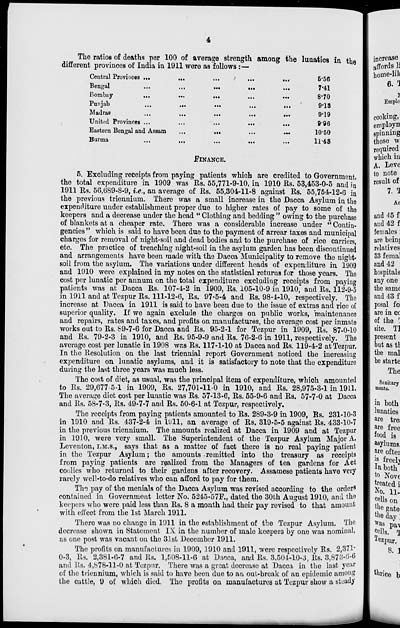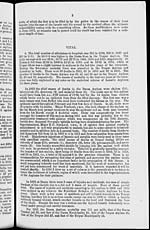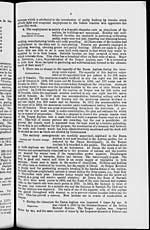Medicine - Mental health > 1903-1911 - Triennial report on the lunatic asylums in the province of Eastern Bengal and Assam > 1909, 1910, 1911 - Triennial report on the lunatic asylums in the province of Eastern Bengal and Assam for the years 1909, 1910, & 1911
(228) Page 4
Download files
Individual page:
Thumbnail gallery: Grid view | List view

4
The ratios of deaths per 100 of average strength among the lunatics in the
different provinces of India in 1911 were as follows:—
|
Central Provinces ... ... ... ... ... |
5.56 |
|
Bengal ... ... ... ... ... |
7.41 |
|
Bombay ... ... ... ... ... |
8.70 |
|
Punjab ... ... ... ... ... |
9.18 |
|
Madras ... ... ... ... ... |
9.19 |
|
United Provinces ... ... ... ... |
9.96 |
|
Eastern Bengal and Assam ... ... ... ... |
10.50 |
|
Burma ... ... ... ... ... |
11.43 |
FINANCE.
5. Excluding receipts from paying patients which are credited to Government,
the total expenditure in 1909 was Rs. 55,771-9-10, in 1910 Rs. 53,453-0-5 and in
1911 Rs. 56,689-8-9, i.e., an average of Rs. 55,304-11-8 against Rs. 55,754-12-6 in
the previous triennium. There was a small increase in the Dacca Asylum in the
expenditure under establishment proper due to higher rates of pay to some of the
keepers and a decrease under the head "Clothing and bedding" owing to the purchase
of blankets at a cheaper rate. There was a considerable increase under "Contin-
gencies" which is said to have been due to the payment of arrear taxes and municipal
charges for removal of night-soil and dead bodies and to the purchase of rice carriers,
etc. The practice of trenching night-soil in the asylum garden has been discontinued
and arrangements have been made with the Dacca Municipality to remove the night-
soil from the asylum. The variations under different heads of expenditure in 1909
and 1910 were explained in my notes on the statistical returns for those years. The
cost per lunatic per annum on the total expenditure excluding receipts from paying
patients was at Dacca Rs. 107-4-2 in 1909, Rs. 105-10-9 in 1910, and Rs. 112-9-5
in 1911 and at Tezpur Rs. 111-12-6, Rs. 97-5-4 and Rs. 98-4-10, respectively. The
increase at Dacca in 1911 is said to have been due to the issue of extras and rice of
superior quality. If we again exclude the charges on public works, maintenance
and repairs, rates and taxes, and profits on manufactures, the average cost per inmate
works out to Rs. 89-7-6 for Dacca and Rs. 95-2-1 for Tezpur in 1909, Rs. 87-0-10
and Rs. 79-2-3 in 1910, and Rs. 95-9-9 and Rs. 76-2-6 in 1911, respectively. The
average cost per lunatic in 1908 was Rs. 117-1-10 at Dacca and Rs. 119-4-2 at Tezpur.
In the Resolution on the last triennial report Government noticed the increasing
expenditure on lunatic asylums, and it is satisfactory to note that the expenditure
during the last three years was much less.
The cost of diet, as usual, was the principal item of expenditure, which amounted
to Rs. 29,677-5-1 in 1909, Rs. 27,701-11-0 in 1910, and Rs. 28,975-3-1 in 1911.
The average diet cost per lunatic was Rs. 57-13-6, Rs. 55-9-6 and Rs. 57-7-0 at Dacca
and Rs. 58-7-3, Rs. 49-7-7 and Rs. 50-6-1 at Tezpur, respectively.
The receipts from paying patients amounted to Rs. 289-3-9 in 1909, Rs. 231-10-3
in 1910 and Rs. 437-2-4 in 1911, an average of Rs. 319-5-5 against Rs. 433-10-7
in the previous triennium. The amounts realized at Dacca in 1909 and at Tezpur
in 1910, were very small. The Superintendent of the Tezpur Asylum Major A.
Leventon, I.M.S., says that as a matter of fact there is no real paying patient
in the Tezpur Asylum; the amounts remitted into the treasury as receipts
from paying patients are realized from the Managers of tea gardens for Act
coolies who returned to their gardens after recovery. Assamese patients have very
rarely well-to-do relatives who can afford to pay for them.
The pay of the menials of the Dacca Asylum was revised according to the orders
contained in Government letter No. 5245-57F., dated the 30th August 1910, and the
keepers who were paid less than Rs. 8 a month had their pay revised to that amount
with effect from the 1st March 1911.
There was no change in 1911 in the establishment of the Tezpur Asylum. The
decrease shown in Statement IX in the number of male keepers by one was nominal,
as one post was vacant on the 31st December 1911.
The profits on manufactures in 1909, 1910 and 1911, were respectively Rs. 2,371-
0-3, Rs. 2,381-6-7 and Rs. 1,508-11-6 at Dacca, and Rs. 3,504-10-3, Rs. 3,873-6-6
and Rs. 4,878-11-0 at Tezpur. There was a great decrease at Dacca in the last year
of the triennium, which is said to have been due to an out-break of an epidemic among
the cattle, 9 of which died. The profits on manufactures at Tezpur show a steady
Set display mode to: Large image | Zoom image | Transcription
Images and transcriptions on this page, including medium image downloads, may be used under the Creative Commons Attribution 4.0 International Licence unless otherwise stated. ![]()
| Permanent URL | https://digital.nls.uk/83166981 |
|---|




